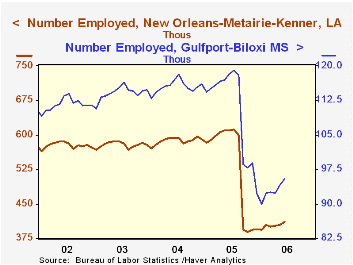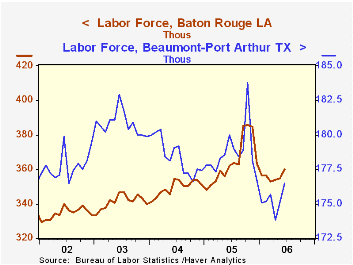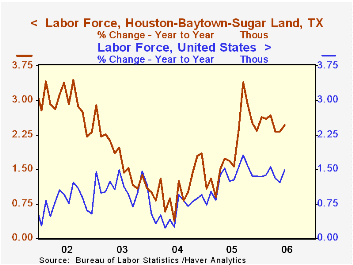 Global| Aug 02 2006
Global| Aug 02 2006Local Employment Data Show Gulf Port Cities Still Struggle 9 Months After Katrina, But Houston Gains
Summary
As the first potential hurricane of 2006, Chris, forms near the Dominican Republic and Cuba, we are reminded, of course, of the drastic impact of last year's Katrina. This morning, the BLS released the household survey data for June [...]

As the first potential hurricane of 2006, Chris, forms near the Dominican Republic and Cuba, we are reminded, of course, of the drastic impact of last year's Katrina. This morning, the BLS released the household survey data for June for metropolitan areas, and we can get an assessment of economic conditions now in some of the affected cities. These data are carried in Haver's EMPLR database. Series for labor force, employment, unemployment and the unemployment rate are included for hundreds of metro areas, micro areas, and the other standard combinations of urban communities in all 50 States, the District of Columbia and Puerto Rico.
In New Orleans, the center of Katrina's damage, the number of people employed is up about 25,000 from its October low, but is clearly still well off the pre-storm numbers. Unemployment, while not at the extreme of October, remains higher than 2003 and 2004, suggesting that even with a reduced labor force, job opportunities are not relatively as plentiful.
Gulfport-Biloxi is also continuing to face strained economic conditions. Unemployment remains far higher than before and also higher than in New Orleans, even though the unemployment rates in the two areas were about the same in the 2003-04 period.
Other cities in the region are doing better. Baton Rouge, the State Capital, saw its unemployment rate shoot up immediately after Katrina, as workers from New Orleans poured into the area. As seen in the table, the rate rose even as the number of employed persons expanded by slightly more than 10,000. Since then, however, employment has fallen back to its pre-storm level and so has unemployment, as the transient workers apparently returned home or moved on.
Cities in Texas also received people from the storm-damaged region. Beaumont-Port Arthur, very near the Louisiana state line, experienced a spike in its labor force and its unemployment rate, but this dissipated. Presently, employment is running about the same as in 2004 and 2005, and the unemployment rate is actually somewhat lower than previously.
Finally, in Houston, the labor force expanded by 25,400 in September and for the most part, these people stayed. Employment rose even more and unemployment fell. Only in June did some of this labor market vigor fade a bit, with a somewhat larger-than-normal June rise in the unemployment rate. So Houston generally was able to absorb its new workers and find jobs for them, and the labor force in Houston is nearly 2.5% larger than a year ago, compared with 1.5% in the nation as a whole.
| Employment, NSA, Thous | June 2006 | May 2006 | Oct 2005 | June 2005 | 2005 | 2004 | 2003 |
|---|---|---|---|---|---|---|---|
| New Orleans, LA* | 412.0 | 404.5 | 388.5 | 610.9 | n.m. | 587.6 | 578.7 |
| Unemployment Rate (%) | 7.2 | 6.4 | 17.1 | 6.1 | n.m. | 5.1 | 5.5 |
| Gulfport-Biloxi, MS | 95.4 | 94.1 | 97.9 | 118.4 | n.m. | 115.5 | 114.1 |
| Unemployment Rate (%) | 12.5 | 12.9 | 21.2 | 6.9 | n.m. | 5.2 | 5.1 |
| Baton Rouge, LA | 341.0 | 339.3 | 348.3 | 338.2 | n.m. | 329.7 | 319.9 |
| Unemployment Rate (%) | 5.3 | 4.4 | 9.7 | 6.7 | n.m. | 5.9 | 6.3 |
| Beaumont-Port Arthur, TX | 164.0 | 164.1 | 163.2 | 166.4 | 164.9 | 163.6 | 165.0 |
| Unemployment Rate (%) | 7.1 | 6.3 | 11.2 | 7.6 | 7.7 | 8.3 | 8.8 |
| Houston, TX* | 2544.0 | 2532.2 | 2521.0 | 2480.3 | 2484.4 | 2419.1 | 2379.2 |
| Unemployment Rate (%) | 5.6 | 5.0 | 5.4 | 5.7 | 5.5 | 6.2 | 6.8 |
Carol Stone, CBE
AuthorMore in Author Profile »Carol Stone, CBE came to Haver Analytics in 2003 following more than 35 years as a financial market economist at major Wall Street financial institutions, most especially Merrill Lynch and Nomura Securities. She had broad experience in analysis and forecasting of flow-of-funds accounts, the federal budget and Federal Reserve operations. At Nomura Securities, among other duties, she developed various indicator forecasting tools and edited a daily global publication produced in London and New York for readers in Tokyo. At Haver Analytics, Carol was a member of the Research Department, aiding database managers with research and documentation efforts, as well as posting commentary on select economic reports. In addition, she conducted Ways-of-the-World, a blog on economic issues for an Episcopal-Church-affiliated website, The Geranium Farm. During her career, Carol served as an officer of the Money Marketeers and the Downtown Economists Club. She had a PhD from NYU's Stern School of Business. She lived in Brooklyn, New York, and had a weekend home on Long Island.





